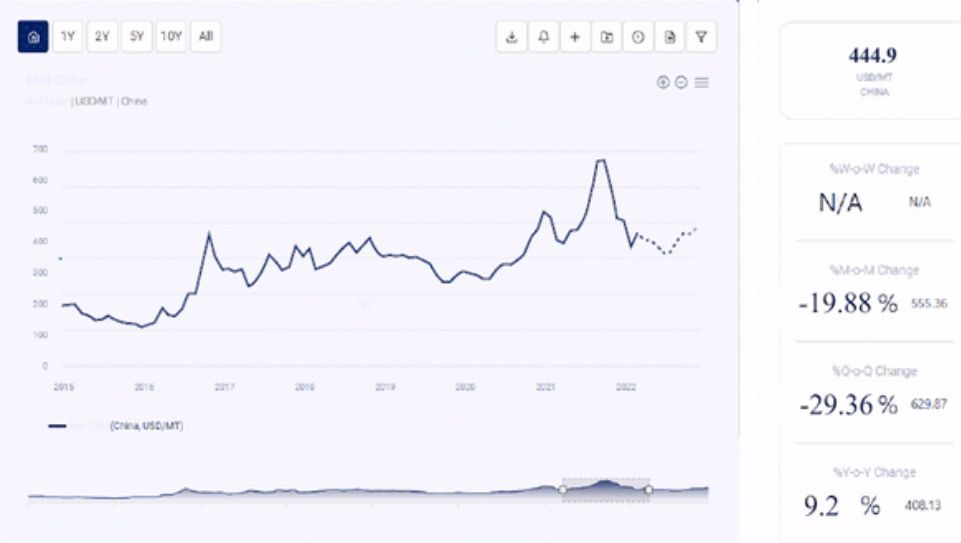Corn is a cereal grain from Corn plants, which is rich in nutrients and bioactive plant-based compounds. It comprises nutrients such as Vitamins, iron, calcium, carotene, carbohydrates, riboflavin, fats, amino acids, sulfur, and proteins.
Request for Real-Time Corn Prices: https://procurementresource.com/resource-center/corn-price-trends/pricerequest
The Corn seeds are found to be golden-yellowish on ripening and are white in colour when raw. The shape may vary and is mostly considered rounded or elliptical in structure. Corn is a storehouse of various antioxidants, such as ferulic acid, which is very useful for preventing skin aging, and hence it is used in manufacturing multiple skin care products. Applications of Corn are found primarily in the food and beverage industries.
The key importing countries for Corn include Taiwan, the United States, and Vietnam. On the other hand, the key exporting countries are the United States, India, and Brazil, in the same order.
Key Details About the Corn Price Trend:
Corn prices are influenced by a variety of factors ranging from agricultural conditions to economic policies. Here are some key details about the trends in corn prices:
- Seasonal Patterns: Corn prices often exhibit seasonal patterns, generally peaking during the early summer months due to planting uncertainties and potential weather disruptions. Prices might decrease later in the year as harvest progresses and actual supply figures become clearer.
- Supply and Demand Dynamics: Like many commodities, the fundamental drivers of corn prices are supply and demand. High yields and sufficient global supplies tend to drive prices down, while poor harvests or increased demand can cause prices to rise. Demand can come from various sectors including food production, livestock feed, and increasingly from biofuel industries.
- Weather Conditions: Weather plays a crucial role in the agricultural sector. Droughts, excessive rainfall, or other adverse weather conditions in major corn-producing regions (such as the U.S. Midwest, Brazil, and Argentina) can significantly impact corn yields and, consequently, prices.
- Global Trade Policies: Trade policies and tariffs can also impact corn prices. For example, tariffs imposed by major importing or exporting countries can alter trade flows and influence global supply and demand dynamics.
- Economic Indicators: Economic health indicators such as GDP growth rates, currency fluctuations, and changes in energy prices can indirectly affect corn prices. For instance, a stronger dollar can make U.S. corn more expensive for other countries, potentially reducing demand and lowering prices.
- Energy Markets: Since a significant portion of corn, particularly in the United States, is used to produce ethanol (a biofuel), the prices of crude oil and gasoline can also influence corn markets. Higher energy prices can increase demand for biofuels, thus pushing up corn prices.
- Government Policies and Subsidies: In some countries, government policies and subsidies for agriculture or biofuels can affect corn production and pricing. For example, subsidies for biofuel production can increase demand for corn, thereby driving up prices.
Monitoring these factors can provide insights into the potential direction of corn prices in the market.
Industrial Uses Impacting Corn Price Trend:

Corn has a wide range of applications in various domains of the global market. It is one of the most dominant crops and is the most productive. As a food, it is grown extensively across the globe for both humans and livestock. It is used in the production of biofuels and is also a crude material in industry. It is the third largest plant-based source of food in the world. The grain is rich in antioxidants and fibres.
Corn flour is used to make dough commonly used in Latin American cuisine to make bread like tortillas, tamales, and arepas. Oil extracted from Corn is used for its flavour and colour, which it provides to the delicacies. Due to its low cholesterol count, Corn oil is also used as a salad and frying oil.
Moreover, Corn oil is converted to margarine by hydrogenation, the common substitute for butter. It is also used to produce ethanol liquid which is a biofuel. Corn ethanol is blended with gasoline to create a volatile liquid known as “Gasohol,” an automotive fuel containing 10% ethanol in it. The grain’s starch makes adhesives, textiles, paper products, and more.
Key Players:
- DuPont de Nemours, Inc
- The Archer Daniels Midland Company
- KWS SAAT SE & Co. KGaA
- Limagrain UK Ltd
- Cargill Incorporated
- Bunge Milling, Inc.
News & Recent Development
- Date: April 11, 2023– The midwestern state of the United States, Kansas faces stagnant growth in the Corn plantations due to a record drought fall in the region.
About Us:
Procurement Resource offers in-depth research on product pricing and market insights for more than 500 chemicals, commodities, and utilities updated daily, weekly, monthly, and annually. It is a cost-effective, one-stop solution for all your market research requirements, irrespective of which part of the value chain you represent.
We have a team of highly experienced analysts who perform comprehensive research to deliver our clients the newest and most up-to-date market reports, cost models, price analysis, benchmarking, and category insights, which help in streamlining the procurement process for our clientele. Our team tracks the prices and production costs of a wide variety of goods and commodities, hence, providing you with the latest and consistent data.
To get real-time facts and insights to help our customers, we work with a varied range of procurement teams across industries. At Procurement Resource, we support our clients, with up-to-date and pioneering practices in the industry, to understand procurement methods, supply chain, and industry trends, so that they can build strategies to achieve maximum growth.
Contact Us:
Company Name: Procurement Resource
Contact Person: Endru Smith
Email: sales@procurementresource.com
Toll-Free Number: USA & Canada – Phone no: +1 307 363 1045 | UK – Phone no: +44 7537 132103 | Asia-Pacific (APAC) – Phone no: +91 1203185500
Address: 30 North Gould Street, Sheridan, WY 82801, USA














